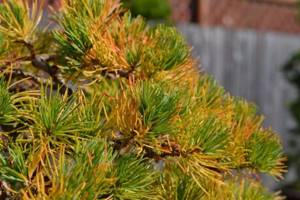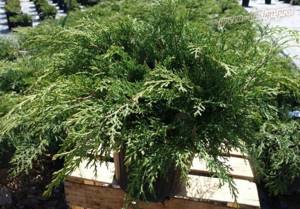Description of ephedra microbiota
Microbiota is a representative of coniferous shrubs from the Cypress family. The genus is represented by a single species – cross-paired microbiota (Microbiota decussata), which includes a small number of varietal varieties.
The Far Eastern regions of Russia are considered to be the homeland of the shrub; due to a significant reduction in numbers, the shrub is listed in the Red Book of the Russian Federation.
The height of the bush shoots reaches 50 cm. The shell-shaped crown is formed from creeping shoots; its diameter can reach two meters.
A feature of Microbiota is the change in color of the needles depending on the season. In spring, the needles of this plant are bright green, in summer they become dark green, and in autumn they gradually acquire a bronze tint. It stays this color until spring returns and then abruptly returns to green.
The shoots are thin, flat in shape, tightly adjacent to the ground. They are covered with scaly needles, rich green in color, about 2 mm long. The needles tightly envelop the shoots, their ends are slightly pointed at the top. Brown cones, round in shape, small. Their length reaches 0.6 mm, width – 0.3 mm. After the scales ripen, the cones open, releasing a rounded seed. The period of seed ripening is summer-early autumn.
You might be interested

Why do coniferous trees turn yellow?

What fertilizers for coniferous plants can be used in the garden

How to care for coniferous plants in your garden
The role of probiotics in the formation of intestinal microbiota in children
Recently, much attention has been paid to the role of probiotics in the correction of intestinal microbiota (IM) disorders in children and adults. The formation of CM occurs in a child immediately after birth. The child receives the most important microorganisms (including bifidobacteria) from the mother [1]. Subsequent development of BM is modulated by specific components present in breast milk that promote selective colonization [2]. This process represents a unique example of coevolution between macro- and microorganisms, with both parties benefiting from this interaction [3]. In recent years, new data have been obtained on the role of the community of intestinal microbes living in the gastrointestinal tract (GIT) of a child, which perform various physiological and metabolic functions [4]. These studies revealed that a decrease in microbial diversity or a change in the composition of BM, usually referred to as “dysbiosis,” can occur both at an early age and in subsequent age periods. The process of accumulating more and more clinical and experimental data helps to understand how the composition of CM in early childhood affects the health status and the formation of a number of diseases in an adult. This concept is based on an in-depth study of the role of probiotics in the development of CM, starting in infancy and early childhood [5].
The importance of gut microbiota
The gastrointestinal tract contains many diverse microorganisms, which represent a complex microbial ecosystem, which has received the modern name “intestinal microbiota” and reaches its maximum number of microorganisms in the large intestine [6]. CM plays a key role in maintaining human health. Various disorders in the composition of CM, designated by the term “dysbiosis,” often become a trigger for the development of a number of allergic, autoimmune and oncological diseases, metabolic disorders and inflammatory processes in the gastrointestinal tract [7]. As means that are actively used to correct the composition of BM in both children and adults, live microbial preparations (probiotics) and compounds that are not broken down by human digestive enzymes, but are fermented by beneficial intestinal microorganisms, are widely used - prebiotics, which primarily include oligosaccharides of breast milk [8].
Only relatively recently has it become possible to study the composition of CM without culturing strains, using metagenomics based on the DNA sequence of microbial cells [9]. Thanks to this, it turned out that only about half of the microorganisms living in the body can be identified using the classical cultivation method, while about 50% of them are unculturable. Modern data obtained using metagenomics provide a more complete picture of the complex composition of CM [10].
The CM contains six types: Firmicutes, Bacteroidetes, Actinobacteria, Tenerientes, Proteobacteria, Fusobacteria. About 90% of the adult microbiome consists of Firmicutes and Bacteroidetes [11], while in children Actinobacteria and especially Bifidobacteria predominate [12]. Adults are characterized by the presence of a more diverse CM, and a larger number of species are identified [13]. Previously, it was believed that the number of microbial cells in the human body is 10 times greater than the number of its own somatic cells, but recent data indicate a 1:1 ratio [14]. As for the ratio of genes collectively represented in the intestinal microbiome, their number is 150 times higher than the number of genes in the human body and amounts to 3.3 million genes of bacterial origin [15]. In addition, the microbial community is constantly under the influence of variable factors associated with the state of the digestive system, including fluctuations in pH levels, high concentrations of bile acids in the duodenum, changing intestinal transit rates, and the diverse influence of nutritional factors. The properties of the microorganisms themselves (adhesive properties, enzymatic activity, etc.) are also important.
Functions of the intestinal microbiota
The microbial community plays a critical role in the breakdown of complex compounds that are not broken down in the upper gastrointestinal tract, primarily proteins, polypeptides and complex carbohydrates. In addition, microbes participate in the breakdown of their own glycans-mucins produced in the gastrointestinal tract, and in a child of the first year of life - breast milk oligosaccharides (BOOM). An important function of CM is competitive protection against pathogenic bacteria. CM is also necessary for the proper development of the immune system [16]. In particular, this manifests itself in the stimulation of the synthesis of secretory IgA, in maintaining the population of various T cells in the intestine, including regulatory T cells (Treg), T helper cells (Th1) and (Th17) [17].
CM plays an important role in the biotransformation of bile acids, the production of vitamins and the synthesis of short-chain fatty acids (SCFA) - acetate, propionate and butyrate. The most important property of SCFAs is their trophic effect on intestinal epithelial cells. For example, butyrate serves as a very valuable energy source for enterocytes.
The indigenous intestinal microbiota has significant individual differences, and different types of microorganisms play opposite roles in some cases. For example, some microbes promote the development of Tregs, while others stimulate the development of T17. That is why a balanced autochthonous microflora is necessary for the normal development of mucosal-associated lymphoid tissue and is involved in the development of tolerance induction mechanisms with the participation of Treg cells. A study on gnotobiont mice showed that Bacteroides fragilis is able to suppress Treg activity and inhibit the production of anti-inflammatory cytokines [18].
In a similar study design, Clostridium strains in germ-free mice were shown to increase IL-10 production by Treg cells in the lamina propria [19]. Various species of bifidobacteria have the ability to modulate Treg production.
Origin of the gut microbiota
It is traditionally believed that the intestine of a newborn is initially sterile, but immediately after birth its active colonization begins. However, this process largely depends on two factors: the method of delivery - physiological, vaginal or cesarean section [20] and the type of feeding - breastfeeding (Breastfeeding) or infant formula (IF). The main changes in the composition of BM occur at the earliest stages of development and depend on whether antibiotic therapy was carried out, whether the child had intestinal infections and on the type of feeding [21].
Intestinal microbiota and atopic diseases (atopic eczema and bronchial asthma)
Among the Th2-mediated diseases associated with the importance of the intestinal microbiota, the most important are atopic dermatitis (AD) and bronchial asthma (BA). It is important to emphasize that the connection between these diseases and the characteristics of the composition of BM can be traced already from the first days after birth.
In children of the first year of life, the most common allergic disease is AD [22]. The connection between BM and the development of AD was proven using the PCR method, which revealed differences in the composition of BM at the age of 1 month, which preceded the appearance of AD symptoms that occurred during the first two children of life.
For example, according to available data, the detection of E. coli in BM is associated with an increased risk of AD, and the presence of Clostridium difficile is associated with the risk of atopic manifestations, such as eczema, shortness of breath and allergic sensitization [20]. These data were obtained from a large study involving 646 children, which established an association between E. coli and the development of IgE-mediated eczema in children of the first year of life [20]. A decrease in the diversity of microbes in BM during this period closely correlates with the development of AD at an early age. It was also found that butyrate-producing bacteria (Coprococcus entactis) help reduce the severity of AD symptoms [24]. Low levels of butyrate production do not affect the clinical course of AD [25].
The uniformity and monotony of the microbial landscape serve as a predisposing background for the development of allergic diseases. A correlation has been established between low levels of Bifidobacteria, Akkermansia and Faecalibacterium and the development of atopic diseases [26]. It is believed that there is a "window of opportunity" where successful early colonization can prevent disease development, for example through the use of probiotics. For example, children who received additional Bifidobacterium breve in the early postnatal period (1 week and 3 months) showed a decrease in the risk of AD in the first year of life [27]. There are also several studies in which probiotic strains were administered to pregnant women [28]. Subsequently, their children had a significantly lower risk of developing AD. These results should be considered encouraging and promising, as well as other data on reducing the risk of food allergies with the administration of probiotics [29].
Epidemiological studies indicate that the characteristics of the early development of CM in a child directly affect the risk of developing AD in subsequent periods of life [30]. The mechanism of this phenomenon is associated with improper formation of BM, which in turn causes a disruption of immune homeostasis in the first year of life [31]. CM plays an important role in perinatal programming [32]. The risk of developing asthma is higher in those children in whom dysbiosis develops in the first 100 days of life and the presence of special microbes is detected. A Canadian study involving 319 children showed that Lachnospira, Veilonella, Faecalibacterium, and Rothia were detected in infants at high risk of developing asthma in the first year of life. This was accompanied by a change in the fecal metabolite profile. In an experiment on mice, it was shown that the administration of these metabolites causes an inflammatory process in the airways and is involved in the etiology of asthma [32, 33].
Another study found that the uniformity of BM composition in children in the first year of life is associated with a high risk of developing AD at 7 years of age [34]. Low levels of Lachnospira and high levels of Clostridium in three-month-old children have a significant association with the onset of asthma at 4 years of age. It has been proposed to use the determination of these two microorganisms as a biomarker for the development of AD [35].
The role of B. breve in the combination drug
Bifidobacteria B. breve are among the microorganisms that are among the first to colonize the gastrointestinal tract of a newborn. They constitute 25% to 80% of the culturable bacteria that are isolated from the stool of both children and adults [36]. B. breve are anaerobic gram-positive microorganisms and do not have mobility [37]. Although they are constantly found in adults, in quantitative terms and especially due to their enzymatic characteristics they are of particular importance for children, starting from the neonatal period [38]. It is precisely due to its special metabolic activity and having the ability to most completely metabolize OGM that B. breve play a leading role as the main representative of BM in breastfed children [39]. B. breve is one of the three most important species of bifidobacteria, which have an indispensable function for a child in the earliest stages of development.
The genome structure of B. breve is characterized by the presence of one circular chromosome, consisting of 2,422,6784-bp with a relatively high proportion of guanine-cytosine (58.7%) in its composition. B. breve are saccharolytic microorganisms, whose existence depends on the presence of complex carbohydrates in the lumen of the gastrointestinal tract as a substrate and source of energy for their life. In addition, B. breve metabolism requires sialic acid, which is present in breast milk. As a result of the fermentation of carbohydrates, B. breve produces lactic and acetic acid (lactate and acetate), creating an acidic environment around itself that has a detrimental effect on opportunistic flora [40]. In addition, these bacteria are capable of synthesizing numerous enzymes (which are absent in humans and animals), including fructose-6-phosphate phosphoketolase, which is capable of fermenting undigested carbohydrates, as well as breaking down GOS - galactooligosaccharides of breast milk. Bifidobacteria are unique in that they are transmitted from mother to child during childbirth, and then their growth is supported and stimulated through breastfeeding due to the unique oligosaccharides of breast milk. Another important component of breast milk, as noted above, is sialic acid, and in the B. breve genome there is a gene cluster whose sole role is to participate in the metabolism of this acid.
Another remarkable fact: B. breve is found both in the gastrointestinal tract of adults and children, as well as in breast milk itself, where it enters through the mechanism of bacterial translocation. As a result of long-term co-evolution with the macroorganism, B. breve exhibits excellent symbiotic interaction, participating in the metabolism of complex indigestible carbohydrates.
It was also noted that with age, the content of B. breve in the body decreases significantly. One explanation for this fact is that this microorganism lacks antibiotic resistance, so any episode of antibiotic therapy becomes a negative factor. It was also noted that the appearance of Shiga toxin-producing E. coli leads to a decrease in the population of B. breve in the body, which once again indicates the important role of B. breve in maintaining intestinal homeostasis.
In biological products such as PREMA Duo Kids, B. breve is used in combination with another probiotic strain, providing an excellent combined effect.
Lactobacillus rhamnosus GG and their role in the composition of the combination drug
Recently, two detailed scientific reviews on the role of lactobacilli LGG have been published, which present the history of the discovery of the strain, the results of numerous experimental and clinical studies, and data from recent meta-analyses on this topic [41, 42]. Therefore, in this section, information about the probiotic strain Lactobacillus rhamnosus GG is presented in a compact form.
LGG is characterized by a number of important properties that contribute to stability in its administration and a high degree of survival in the human body, including in children from the neonatal period.
The most important property that determines the therapeutic potential of any probiotic is resistance when passing the gastric and intestinal barrier, including resistance to high concentrations of bile salts in the duodenum and small intestine. Thanks to this stability, LGGs are able to safely bypass an aggressive environment and reach a comfortable place of residence in the lumen of the colon. It should be noted that such resistance is facilitated by the fact that the LGG genome contains a gene encoding bile acid hydrolase. This provides a high degree of resistance to bile acids present in the upper gastrointestinal tract and contributes to the successful survival of LGG in the hostile duodenal and small intestinal environment.
The LGG strain has a whole set of properties that allow it to inhibit opportunistic and pathogenic microorganisms, due to which this strain is able to competitively interact with potentially dangerous microorganisms and, moreover, has a certain therapeutic activity in acute intestinal infections. Thanks to flagella-like structures - pili, LGG can be fixed on the surface of intestinal epithelial cells, thereby preventing the fixation of harmful microorganisms.
Among the mechanisms of competitive interaction of LGGs is their ability to produce lactate and produce bactericins, which creates an unfavorable environment for opportunistic microorganisms.
LGG also has the ability to degrade toxins released by other bacterial cells. The ability of LGG to develop in the parietal mucus and interact with cellular receptors, leaving intestinal epithelial cells intact, is very important.
Since 1987, LGGs have been repeatedly studied in a variety of clinical trials and in a wide variety of indications, including patient populations such as newborns and premature infants, pregnant and lactating women, and adults and older adults with various diseases [43]. Several meta-analyses have been published demonstrating the high degree of efficacy and safety of LGG.
As is known, CM is a metabolically active organ, and thanks to its well-studied properties, the LGG strain makes an important contribution to the state of metabolic processes occurring in the colon. While having a major impact on modulating the intestinal microbiota, LGG also plays a key role in the formation and stimulation of gut-associated lymphoid tissue, thereby supporting the body's immune system. According to a number of authoritative researchers, the absolute predominance of bifidobacteria and lactobacilli in the composition of CM represents “the healthiest microbial composition.”
The main advantages of PREMA Duo Kids (Lactobacillus rhamnosus GG + B. breve BR03) are the possibility of its use in children from the first month of life and a convenient children's form in the form of easily dosed drops, since there is a sterile measuring pipette inside the package. The standard dosage is 5 drops per day, which contain: viable bacteria Lactobacillus rhamnosus GG - 0.5 × 109 CFU and viable bacteria B. breve BR03 - 0.5 × 109 CFU (total viable bacteria - 1.0 × 109 CFU). The volume of the bottle (10 ml) is designed for more than a month of use. The drug contains non-allergenic strains. Each bacterial cell is protected by a microcapsule, so there is no need to store the package in the refrigerator even after opening it. Corn oil was used as an excipient - it is the most resistant to rancidity and oxidation in air. The product is also convenient because it has no taste. This is a completely ready-to-use form.
Literature
- Milani C., Duranti S., Bottacini F., Casey E., Turroni F., Mahony J. et al. The first microbial colonizers of the human gut: composition, activities, and health implications of the infant gut microbiota // Microbiol Mol Biol Rev. 2017; 81(4).
- Penders J., Thijs C., Vink C., Stelma FF, Snijders B., Kummeling I. et al. Factors influencing the composition of the intestinal microbiota in early infancy // Pediatrics. 2006; 118(2):511–521.
- Ley RE, Hamady M, Lozupone C, Turnbaugh PJ, Ramey RR, Bircher JS et al. Evolution of mammals and their gut microbes // Science. 2008; 320(5883):1647–1651.
- Munyaka PM, Khafipour E., Ghia JE External influence of early childhood establishment of gut microbiota and subsequent health implications // Front Pediatr. 2014; 2:109.
- Saavedra JM, Dattilo AM Early development of intestinal microbiota: implications for future health // Gastroenterol Clin N Am. 2012; 41(4):717–731.
- Palmer C., Bik EM, DiGiulio DB, Relman DA, Brown PO Development of the human infant intestinal microbiota // PLoS Biol. 2007; 5(7):e177.
- Koenig JE, Spor A, Scalfone N, Fricker AD, Stombaugh J, Knight R et al. Succession of microbial consortia in the developing infant gut microbiome // Proc Natl Acad Sci USA. 2011; 108(Suppl. 1): 4578–4585.
- Wong JM, de Souza R., Kendall CW, Emam A., Jenkins DJ Colonic health: fermentation and short chain fatty acids // J Clin Gastroenterol. 2006; 40 (3): 235–243.
- Hopkins MJ, Macfarlane GT, Furrie E., Fite A., Macfarlane S. Characterization of intestinal bacteria in infant stools using real-time PCR and northern hybridization analyses. // FEMS Microbiol Ecol. 2005; 54(1):77–85.
- Gill SR, Pop M, Deboy RT, Eckburg PB, Turnbaugh PJ, Samuel B S. et al. Metagenomic analysis of the human distal gut microbiome // Science. 2006; 312(5778):1355–1359.
- Rajilic-Stojanovic M., Smidt H., de Vos WM Diversity of the human gastrointestinal tract microbiota revisited // Environ Microbiol. 2007; 9(9):2125–2136.
- Turroni F., Peano C., Pass DA, Foroni E., Severgnini M., Claesson MJ et al. Diversity of Bifidobacteria within the infant gut microbiota // PLoS One. 2012; 7(5):e36957.
- Eckburg PB, Bik EM, Bernstein CN, Purdom E, Dethlefsen L, Sargent M et al. Diversity of the human intestinal microbial flora // Science. 2005; 308(5728):1635–1638.
- Sender R., Fuchs S., Milo R. Revised estimates for the number of human and bacteria cells in the body // PLoS Biol. 2016; 14(8):e1002533.
- Qin J., Li R., Raes J., Arumugam M., Burgdorf KS, Manichanh C. et al. A human gut microbial gene catalog established by metagenomic sequencing // Nature. 2010; 464 (7285): 59–65.
- Kaplan JL, Shi HN, Walker WA The role of microbes in developmental immunologic programming // Pediatr Res. 2011; 69(6):465–72.
- Gaboriau-Routhiau V., Rakotobe S., Lecuyer E., Mulder I., Lan A., Bridonneau C. et al. The key role of segmented filamentous bacteria in the coordinated maturation of gut helper T cell responses // Immunity. 2009; 31(4):677–689.
- Mazmanian SK, Round JL, Kasper DL A microbial symbiosis factor prevents intestinal inflammatory disease // Nature. 2008; 453(7195):620–625.
- Atarashi K., Tanoue T., Shima T., Imaoka A., Kuwahara T., Momose Y. et al. Induction of colonic regulatory T cells by indigenous Clostridium species // Science. 2011; 331(6015):337–341.
- Penders J., Thijs C., Vink C., Stelma FF, Snijders B., Kummeling I. et al. Factors influencing the composition of the intestinal microbiota in early infancy // Pediatrics. 2006; 118(2):511–521.
- Koenig JE, Spor A, Scalfone N, Fricker AD, Stombaugh J, Knight R et al. Succession of microbial consortia in the developing infant gut microbiome // Proc Natl Acad Sci USA. 2011; 108(Suppl 1):4578–4585.
- Kalliomaki M., Salminen S., Arvilommi H., Kero P., Koskinen P., Isolauri E. Probiotics in primary prevention of atopic disease: a randomized placebocontrolled trial // Lancet. 2001; 357(9262):1076–1079.
- Penders J., Thijs C., van den Brandt PA, Kummeling I., Snijders B., Stelma F. et al. Gut microbiota composition and development of atopic manifestations in infancy: the KOALA Birth Cohort Study // Gut. 2007; 56(5):661–667.
- Wang M., Karlsson C., Olsson C., Adlerberth I., Wold AE, Strachan DP et al. Reduced diversity in the early fecal microbiota of infants with atopic eczema // J Allergy Clin Immunol. 2008; 121(1):129–134.
- Nylund L., Nermes M., Isolauri E., Salminen S., de Vos WM, Satokari R. Severity of atopic disease inversely correlates with intestinal microbiota diversity and butyrate-producing bacteria // Allergy. 2015; 70(2):241–244.
- Simonyte Sjodin K., Vidman L., Ryden P., West CE Emerging evidence of the role of gut microbiota in the development of allergic diseases // Curr Opin Allergy Clin Immunol. 2016; 16 (4): 390–395.
- Fujimura KE, Sitarik AR, Havstad S, Lin DL, Levan S, Fadrosh D et al. Neonatal gut microbiota associates with childhood multisensitized atopy and T cell differentiation //. Nat Med. 2016; 22 (10): 1187–1191.
- Ismail IH, Boyle RJ, Licciardi PV, Oppedisano F, Lahtinen S, Robins-Browne RM et al. Early gut colonization by Bifidobacterium breve and B. catenulatum differentially modulates eczema risk in children at high risk of developing allergic diseas //. Pediatr Allergy Immunol. 2016; 27(8):838–846.
- Isolauri E., Arvola T., Sutas Y., Moilanen E., Salminen S. Probiotics in the management of atopic eczema // Clin Exp Allergy. 2000; 30 (11): 1604–1610.
- Feehley T., Plunkett CH, Bao RY, Hong SMC, Culleen E., Belda-Ferre P. et al. Healthy infants harbor intestinal bacteria that protect against food allergy // Nat Med. 2019; 25(3):448.
- Johnson CC, Ownby DR The infant gut bacterial microbiota and risk of pediatric asthma and allergic diseases // Transl Res. 2017; 179: 60–70.
- Johnson CC, Ownby DR Allergies and asthma: do atopic disorders result from inadequate immune homeostasis arising from infant gut Dysbiosis? // Expert Rev Clin Immunol. 2016; 12 (4): 379–388.
- Azad MB, Kozyrskyj AL Perinatal programming of asthma: the role of gut microbiota // Clin Dev Immunol. 2012; 2012: 932072.
- Arrieta MC, Stiemsma LT, Dimitriu PA, Thorson L, Russell S, Yurist-Doutsch S, et al. Early infant microbial and metabolic alterations affect the risk of childhood asthma // Sci Transl Med. 2015; 7 (307): 307ra152.
- Abrahamsson TR, Jakobsson HE, Andersson AF, Bjorksten B., Engstrand L., Jenmalm MC Low gut microbiota diversity in early infancy precedes asthma at school age // Clin Exp Allergy. 2014; 44(6):842–850.
- Stiemsma LT, Arrieta MC, Dimitriu PA, Cheng J, Thorson L, Lefebvre DL et al. Shifts in Lachnospira and Clostridium sp. in the 3-month stool microbiome are associated with preschool age asthma // Clin Sci. 2016; 130(23):2199–2207.
- Picard C., Fioramonti J., Francois A., Robinson T., Neant F., Matuchansky C. Review article: bifidobacteria as probiotic agents - physiological effects and clinical benefits // Aliment Pharmacol Ther. 2005, 22: 495–512.
- Egan M., O'Connell Motherway M., Ventura M., van Sinderen M. Genetics and Molecular Biology Metabolism of Sialic Acid by Bifidobacterium breve // Environ. Microbiol 2014, 80: 14, 4414–4426.
- Tabbers MM, de Milliano I., Roseboom MG, Benninga MA Is Bifidobacterium breve effective in the treatment of childhood constipation? Results from a pilot study // Nutr J. 2011, 10: 19.
- Mayo B. Bifidobacteria: Genomics and molecular aspects. Norfolk, UK: Caister Academic, 2010.
- Fushinobu S. Unique Sugar Metabolic Pathways of Bifidobacteria // Bioscience, Biotechnology and Biochemistry. 2010, 74 (12), 2374–2384.
- Zakharova I. N., Borzova E. Yu., Simakova M. A. Lactobacillus rhamnosus GG: experience of use in pediatric gastroenterological practice // Russian Bulletin of Perinatology and Pediatrics. 2019; 64 (6): 20–29.
- Gribakin S. G., Timofeeva A. G., Bokovskaya O. A. Probiotic Lactobacillus rhamnosus GG (LGG®): what do we know about effectiveness and safety? // Attending doctor. 2021, no. 4, 92–95.
- Makarova S. G., Namazova-Baranova L. S., Ereshko O. A., Yasakov D. S., Sadchikov P. E. Intestinal microbiota and allergies. Pro- and prebiotics in the prevention and treatment of allergic diseases // Pediatric pharmacology. 2019; 16 (1): 7–18.
S. G. Gribakin, Doctor of Medical Sciences, Professor
Federal State Budgetary Educational Institution of Further Professional Education RMANPE of the Ministry of Health of Russia, Moscow
Contact Information
DOI: 10.26295/OS.2020.85.98.001
The role of probiotics in the formation of intestinal microbiota in children / S. G. Gribakin For citation: Attending physician No. 4/2020; Page numbers in the issue: 7-11 Tags: children, newborns, immunity, probiotic
Rules for growing microbiota cross-pair
Coniferous trees and shrubs, as a rule, are quite independent and require little human help. With proper care, Microbiota decussata will provide you with a charming look for many years.

The soil
Moist and well-drained soils will ensure the best growth for your shrub. These plants can tolerate poor soils, but they grow quickly in loam soils.
Whenever possible, use a quickly decomposing mulch, such as dried leaves, around new plantings. This helps keep the soil moist and protects it from erosion. Once the plant takes root and grows in size, it becomes living mulch. In winter, wood chip mulch will protect the plant's roots from cold damage.
Lighting
While most coniferous crops prefer sunlight, Microbiota prefers partial shade. In fact, that's where it grows best. Although the plant can tolerate full sun in milder climates, it is easiest to plan for shelter. It can grow in complete shade, but performs best if it receives at least some sunlight.
Water
The plant likes constant humidity, but does not like standing water. The soil should be evenly moist, but not soggy. Once established, the microbiota is very drought tolerant. Its roots can draw moisture from the depths.
A slow, gradual watering method is preferred for this plant. It is best to use drip irrigation to soak the soil under your plants. This allows moisture to seep into the soil and penetrate completely. Water only when the soil is dry at the surface, but give it a long, slow watering to thoroughly saturate the soil.
If you have a humid climate, make sure your plant has shade during the hottest parts of the day. The combination of humidity and heat can slow its growth. Nighttime humidity doesn't matter.
Fertilizers
If you plan to fertilize, it is best to do it in early spring, before new shoots emerge. Use a balanced, slow-release fertilizer, preferably in granular form. They are easy to apply at the base of your plants.
But don't think that this is a necessity. The microbiota tolerates poor soil nutrition well. It will survive even without fertilizer. If your soil is rich enough, you can skip feeding at all.
Trimming
Carry out pruning in early spring, focusing on the tips of the branches. Be sure to prune before the plant starts to green up again. This annual sanitary pruning promotes bushier growth. You can also perform formative pruning to prevent the crown of the bush from growing. When pruning, be sure to use clean pruning shears to make a clean cut.
Description and varieties
Microbiota cross-paired is a coniferous shrub belonging to the Cypress family.
The second type of shrub is Goldspot.

This microbiota variety is larger in size than Jacobsen. At the age of ten, the plant reaches 0.5 m in height and 150 cm in diameter. At the ends the needles have a creamy tint. Its main part is green. Cones ranging in size from 30 to 60 mm have only one seed, which ripens in early September. The roots go deep underground. Loves shade and needs shelter from the wind.
Growing microbiota is impossible without applying fertilizers. You can use mullein solution.
- Give the microbiota a lot of microelements.
- Remove nitrogen from fertilizing.
- Use magnesium as the main component of nutrition.
The microbiota needs to be fed twice a year. It is best to do the first feeding in May, the second in August, in order for the plant to prepare for winter.
In May, it is best to fertilize the bush with the preparation “Uniflor Bud” - it contains magnesium, almost no nitrogen and many microelements. “Uniflor Cactus” is also suitable - among other things, it contains calcium and the same amount of microelements as in “Uniflor Bud”.
It is very important to loosen the soil where the roots of the microbiota lie. Loosening is necessary to destroy soil compaction and remove the roots of harmful plants
You need to loosen it very carefully so as not to damage the roots of the bush. Loosening is carried out in the spring as soon as the snow melts and the ground dries out from the excess moisture in it. Further loosening is carried out as necessary - when the soil is compacted. Most often they are loosened during the growing season.
Weeding is necessary to control weeds: they take away light from the bush, territory for growth and useful substances from the ground. In addition, weeds favor the development of diseases in the plant, as well as the appearance of harmful insects on it. The use of chemicals is undesirable. They are used only in emergency cases.
The shrub does not tolerate transplantation without a root ball. For transplantation, shoots lying on the soil are used. Cuttings are taken 8-10 cm in size. It is necessary to use root formation stimulants, such as “Kornerost”, “Heteroauxin”, “Kornevin”.

It is also necessary to maintain temperature and humidity conditions. In the fall, about 90% of the cuttings can be transplanted into a schoolhouse, as they form good rhizomes.
In order for the bush to overwinter well, it needs to be prepared for winter. To do this, at the end of autumn it must be thoroughly watered. You need to pour at least two buckets under each bush. In winter, the snow that has covered the microbiota must be swept away, as it can break the branches of the bush.
Microbiota Reproduction
The shrub reproduces by seed and vegetative methods. Considering that Microbiota is a dioecious plant in which males predominate, propagating it by seed is quite problematic. Females begin to produce seeds only from the fifteenth year of life.

Vegetative propagation is a faster option to get a new plant. The branching technique is widely used, when branches pressed to the ground take root, giving life to a new bush.
Cuttings are also widely used for propagation. Cuttings are carried out throughout spring and summer. For cuttings, young, healthy, annual shoots about 10 cm long are used. The edge of the shoot is treated with a rhizome stimulating agent and planted in a container. During the rooting process, you need to keep the soil moderately moist.
Transplantation of cross-pair Microbiota into open ground is carried out in the next season, when the root system has grown sufficiently and become stronger. When planting, the rhizome is not buried in the ground. The planting hole should be slightly larger than the roots of the plant. When planting Microbiota, be sure to use large crushed stone or other drainage material, which will optimize the moisture level and allow the shrub to develop better. The distance between single plantings should be at least one meter, and for group plantings - about 5 cm.
Microbiota in photos and “live”
#BREAK#
If you don’t know in advance that it is microbiota in the image, the photo can easily be mistaken for one of the juniper varieties. And no wonder. Even the discoverer, botanist I.K. Shishkin, initially decided that he had discovered a certain “false Cossack juniper” ( Juniperus pseudosabina
). However, it is worth looking at the shrub in more detail, and a guess comes: this is not a juniper, not a thuja or a cypress.
The branches of the microbiota are located in a very characteristic way, namely, they are spread out in a horizontal plane, layering on top of each other in the form of tiers. The needles in the form of soft scales are located oppositely, crosswise (which gave the shrub its name). Inside the bush you may find needle-shaped, but also not prickly, needles. In some specimens, the ends of the shoots fall slightly, while in others they are gracefully curved upward, like the cornices of a Chinese pagoda.
Microbiota decussata
– a creeping plant: its branches are capable of rooting, which is very convenient for propagating microbiota by cuttings and layering. The height of the bush does not exceed a meter, and increases very, very slowly - a centimeter, two per year. But the width of the overgrown cross-paired microbiota can reach five or more meters, and is very reminiscent of a springy pillow. Its local name, “korumkurinda”, is translated from Udege as a pillow on a scree.

By the way, thin and seemingly pliable branches are surprisingly durable! If you plant microbiota near the playground, the children will play, jump or simply relax on this natural “featherbed” to their heart’s content, and the microbiota will pass all tests with honor. In their homeland, thickets of microbiota are a real bear paradise: bear cubs love to tumble and fuss there, and adult animals are not averse to basking on the elastic pine paws.
Problems in caring for coniferous shrubs
Overwatering is the most common and dangerous problem for your plant. Cross-paired microbiota does not tolerate standing water - remember this.
A hot climate can be very, very dangerous for a plant. Large amounts of direct sunlight in warmer regions can be deadly to plants. The shrub must be kept in complete shade. The cross-paired microbiota prefers cooler regions.
Don't panic when your plant turns bronze in winter! This is a normal process. It will turn green again in the spring. Mulch the base of the plant with wood chips to protect the roots from the cold.
Pests and diseases
Unlike many other ground cover plants, the shrub is practically not attacked by pests.
The microbiota is immune to many types of plant diseases. Damaged roots can sometimes be susceptible to bacterial or fungal rot. Likewise, damage to the base of the plant can leave it open to bacterial infection. But in general this is unlikely.
Transplantation and wintering
The microbiota is cross-paired, the cultivation of which does not cause any special problems, and is perfectly transplanted. Due to the structure of the root system, an earthen coma does not form around the plant. Therefore, even adult plants can be replanted. The bushes react to this absolutely painlessly and take root well in the new place. In addition, the microbiota perfectly accepts formative pruning. It should be carried out no later than the first ten days of May.
Although this shrub is frost-resistant and does not need to be wrapped for the winter, it is still better to protect young seedlings from the cold. To do this, you can lay a thick layer of dry leaves or mulch obtained from spruce branches.
Application of cross-pair Microbiota in garden design
Due to its external beauty, it is widely used for landscaping summer cottages in single plantings and in group plantings.

Often the microbiota is planted in the foreground of large coniferous plants, which creates a contrast of figures and puts accents in the composition. Good susceptibility to growth on slopes and mountainous areas makes the shrub an ideal solution for rock gardens and rockeries.
This plant is often used on hillsides to control erosion. This is an excellent replacement for a lawn. When combined with other evergreens, it can be quite colorful. The plant is especially often used in coniferous compositions. Its dark bronze autumn color makes the bush stand out among greener plants.







